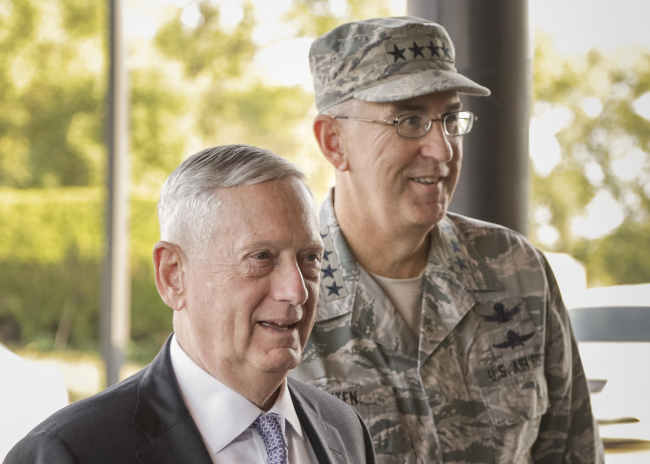The top commander of US nuclear forces said Thursday he assumes the Sept. 3 nuclear test by North Korea was a hydrogen bomb, suggesting a heightened US concern that the North has advanced to a new level of nuclear firepower.
Air Force Gen. John E. Hyten, commander of Strategic Command, told reporters that while he was not in a position to confirm it, he assumes from the size of the underground explosion and other factors that it was a hydrogen bomb _ which is a leap beyond the fission, or atomic, bombs North Korea has previously tested.

North Korea claimed they exploded a hydrogen bomb, and while US officials have not contradicted them, they have not confirmed it, either. Administration officials had indicated they saw nothing to contradict the North's claim. Hyten went further, saying the characteristics of the test made him think it was an H-bomb.
Hyten would not discuss the exact size of the explosion from the Sept. 3 test, but Defense Secretary Jim Mattis said Wednesday that it was in excess of 100 kilotons _ far larger than any of the North's five previous nuclear tests.
"When I look at a thing that size, I as a military officer assume that it's a hydrogen bomb," Hyten said. As head of Strategic Command, he would be in charge of all elements of the US nuclear force in the event of nuclear war.
"I have to (assume this)," he added, "I have to make that assumption. What I saw equates to a hydrogen bomb. I saw the event. I saw the indications that came from that event. I saw the size, I saw the reports, and therefore to me I'm assuming it was a hydrogen bomb."
Asked whether it matters that the North Koreans had advanced to testing a hydrogen bomb, Hyten said, "Yes. The change from the original atomic bomb to the hydrogen bomb for the United States" in the 1940s changed America's strategic relationship with the Soviet Union because of "the sheer destruction and damage you can create with a weapon that size." The Soviets quickly matched the US by exploding their own hydrogen bomb well before US officials believed possible.
Pressed further, Hyten said he was not confirming that it was a hydrogen bomb.
"I'm just saying the size of the weapon shows that there was clearly a secondary explosion," he said.
Until a fission, or atomic, bomb, a hydrogen bomb is built with two "stages," or explosive devices that work in tandem to create fusion.
Hyten would not say how large the explosion was, but Defense Secretary Jim Mattis said on Wednesday that it was more than 100 kilotons, which could put it in the category of an H-bomb.
Hyten said that while he believes it is only a matter of time before the North Koreans have a reliable nuclear-armed missile capable of hitting the United States, they probably still have more test work to do.
"They haven't put everything together yet," he said, referring to the ability to build a long-range missile with a nuclear warhead that can survive the extreme heat generated by re-entering the Earth's atmosphere on its way to a US target. He said it would not be a surprise if the North Koreans were able to do that in fairly short order; he said it took the US "less than a couple of years." (AP)








![[Graphic News] More Koreans say they plan long-distance trips this year](http://res.heraldm.com/phpwas/restmb_idxmake.php?idx=644&simg=/content/image/2024/04/17/20240417050828_0.gif&u=)
![[KH Explains] Hyundai's full hybrid edge to pay off amid slow transition to pure EVs](http://res.heraldm.com/phpwas/restmb_idxmake.php?idx=644&simg=/content/image/2024/04/18/20240418050645_0.jpg&u=20240419100350)






![[From the Scene] Monks, Buddhists hail return of remains of Buddhas](http://res.heraldm.com/phpwas/restmb_idxmake.php?idx=652&simg=/content/image/2024/04/19/20240419050617_0.jpg&u=20240419175937)

![[KH Explains] Hyundai's full hybrid edge to pay off amid slow transition to pure EVs](http://res.heraldm.com/phpwas/restmb_idxmake.php?idx=652&simg=/content/image/2024/04/18/20240418050645_0.jpg&u=20240419100350)

![[Today’s K-pop] Illit drops debut single remix](http://res.heraldm.com/phpwas/restmb_idxmake.php?idx=642&simg=/content/image/2024/04/19/20240419050612_0.jpg&u=)